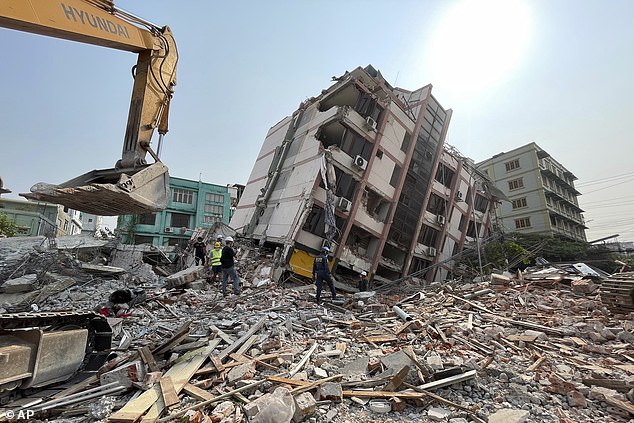It is predicted to be one of the most devastating earthquakes in history.
And now scientists have issued a chilling warning about ‘The Big One’ – a mega–earthquake set to rock California’s notorious San Andreas fault.
Experts from Caltech in Pasadena have studied a 7.7–magnitude earthquake that shook Myanmar in March along the Sagaing fault – a fault known for being eerily similar to San Andreas.
That earthquake ended up rupturing a much longer section of the fault than scientists expected, killing thousands and causing widespread damage.
According to the researchers, this suggests The Big One could also be even bigger than we originally thought.
‘Future earthquakes might not simply repeat past known earthquakes,’ said Jean–Philippe Avouac, co–author of the study.
‘Successive ruptures of a given fault, even as simple as the Sagaing or the San Andreas faults, can be very different and can release even more than the deficit of slip since the last event.
‘In addition, historical records are generally far too short for statistical models to represent the full range of possible earthquakes and eventual patterns in earthquake recurrence.’

The devastating earthquake hit Myanmar on 28 March 2025, killing more than 2,000 people, and leaving 3,900 injured

Experts from Caltech in Pasadena have studied a 7.7–magnitude earthquake that shook Myanmar in March along the Sagaing fault – a fault known for being eerily similar to the San Andreas
The devastating earthquake hit Myanmar on 28 March 2025, killing more than 2,000 people, and leaving 3,900 injured.
The quake occurred when a section of the Sagaing fault ruptured, causing widespread damage along a swathe of territory down the middle of the country, including Sagaing, Mandalay, Magway and Bago regions and Shan State.
In their new study, the Caltech team used satellite imagery of the Sagaing Fault’s motion to understand exactly what happened – and whether a similar incident could happen in California.
‘This earthquake turned out to be an ideal case to apply image correlation methods that were developed by our research group,’ said Solène Antoine, first author of the study.
‘They allow us to measure ground displacements at the fault, where the alternative method, radar interferometry, is blind due to phenomenon like decorrelation [a process to decouple signals] and limited sensitivity to north–south displacements.’
Based on studies of previous tremors along the Sagaing fault, the researchers expected that the earthquake would occur on a 186–mile (300–kilometer) section of the fault, where no large earthquakes had occurred since 1839.
The satellite images confirmed that this was the case – but that the fault actually slipped along a total of more than 310 miles (500km).
In fact, the 310–mile section shifted by a whopping 9.8ft (three metres) after the quake.

It is predicted to be one of the most devastating earthquakes in history. And now scientists have issued a chilling warning about ‘The Big One’ – a mega–earthquake set to rock California’s notorious San Andreas fault
So, what does this mean for The Big One?
Well, according to the researchers, it suggests The Big One won’t look like anything we’ve seen before.
Previous earthquakes on the San Andreas Fault include a 7.9–magnitude earthquake in 1857, which ruptured the fault from Monterey County all the way to Los Angeles County.
Read More
BREAKING NEWS Earthquake swarm rattles SoCal sparking ‘The Big One’ fears

Meanwhile, in 1906, an earthquake began just offshore of San Francisco, before rupturing in two directions, towards Humboldt County and Santa Cruz County.
Instead, a future rupture could result in smaller, separate earthquakes.
Or, it could be even bigger than those seen before – rupturing the fault all the way into San Bernardino, Riverside, and Imperial counties, and reaching a magnitude of 8.
The researchers now hope to use their new models to better understand what The Big One will actually look like.
‘Physics–based models provide an alternative approach with the advantage that they could, in principle, be tuned to observations and used for time–dependent forecast,’ Professor Avouac added.
